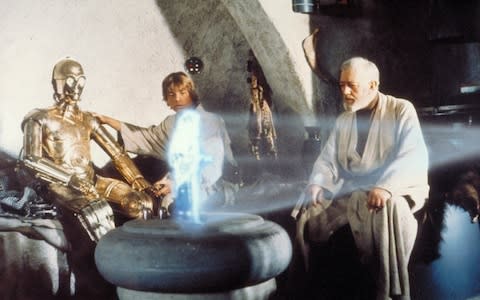Scientists close to creating Star Wars Princess Leia hologram

A hologram that can be seen, heard and felt has been invented by British scientists.
Academics at the University of Sussex say the technology comes close to recreating the three-dimensional message sent by Princess Leia in Star Wars.
The device, dubbed the Multimodal Acoustic Trap Display (MATD), is capable of showing a coloured butterfly gently flapping in mid-air, emojis and other images without the need for virtual reality headsets.
It works by trapping a tiny polystyrene ball between soundwaves and moving it quickly while shifting its colour to create an optical illusion that there is an object suspended in space.
Lead author Dr Ryuji Hirayama, a JSPS scholar and Rutherford Fellow at the University of Sussex, said: “Our new technology takes inspiration from old TVs which use a single colour beam scanning along the screen so quickly that your brain registers it as a single image.
“Our prototype does the same using a coloured particle that can move so quickly anywhere in 3D space that the naked eye sees a volumetric image in mid-air.”

As well as visual content, the prototype developed by a team at the University of Sussex’s School of Engineering and Informatics can also play sound and can stimulate the skin when touched to make it feel like the object is really there.
Project leader Sri Subramanian, Professor of Informatics at the University of Sussex and a Royal Academy of Engineering Chair in Emerging Technologies, said: “ It is not just that the content is visible to the naked eye and in all ways perceptually similar to a real object while still allowing the viewer to reach inside and interact with the display.”
As well as being useful for display or entertainment purposes, it could also help scientists to manipulate matter without touching, allowing researchers to mix chemicals without contaminating them or conduct ultrasound levitation to accurately deliver drugs into tissues.
Dr Hirayama added: “More powerful ultrasound speakers, more advanced control techniques or even the use of several particles, could allow for more complex, stronger tactile feedback and louder audio.
“So even though we have yet to match the Rebel Alliance’s communications capability, our prototype has come the closest yet and opened up a host of other exciting opportunities in the process.”
The research was published in the journal Nature.

 Yahoo News
Yahoo News 